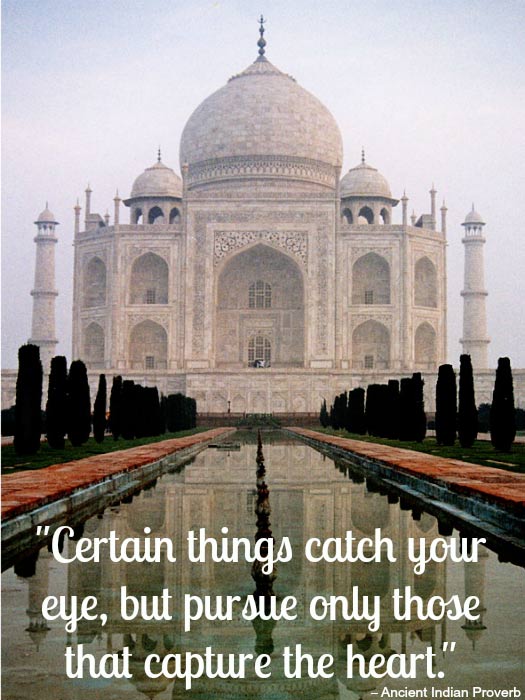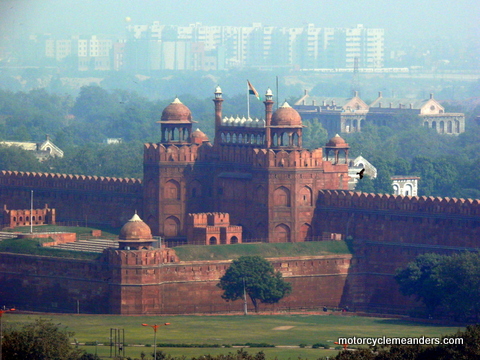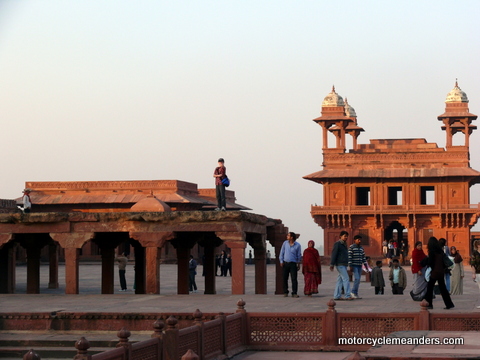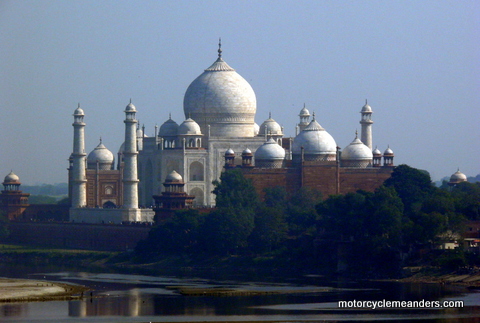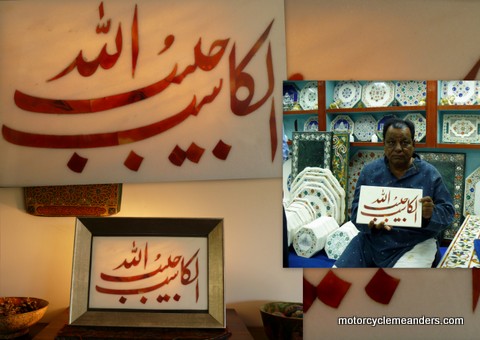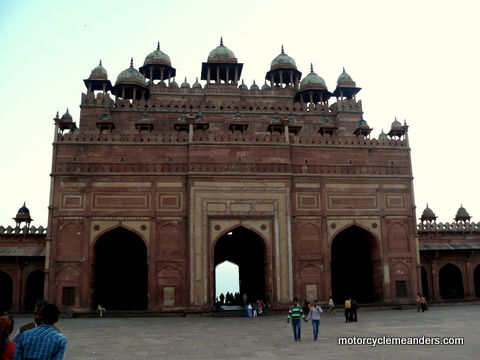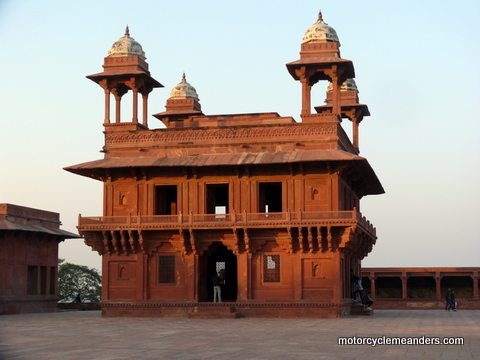
 |
|
Delhi and Agra 2010-2014
Prelude During four visits to India on motorcycle tours, Delhi and Agra became a key focus for add-on sightseeing. Both cities have an impressive array of architecture and other historic reminders from the glory days of the Mughal Empire. In addition, Delhi has an impressive collection of architectural remnants from the Lodi Sultanate (an Afghan dynasty) that preceded the Mughal conquest. The stand-out attraction is the Taj Mahal in Agra. That was built by the fifth Mughal Emperor, Shah Jahan. It was the last great architectural legacy of the Mughal Empire, which started to unravel soon after Shah Jahan’s reign.
The second Mughal Emperor, Humayun, built his capital in Delhi, with the Purana Qila (the Old Fort) as its centrepiece. Humayun’s tomb – often seen as the new benchmark for Mughal architecture, with its massive dome – is nearby the Old Fort in Delhi. The third Mughal Emperor, Akbar the Great, undertook large-scale restructuring of the Agra Fort and built his new capital near Agra at Fatehpur Sikri, which he abandoned 14 years later. The legacy of Shah Jahan (Akbar’s grandson), however, outstrips his predecessors’. Not only did he build the Taj Mahal, but also the Red Fort and Jama Masjid in Delhi as well as the magnificent palaces inside the Agra Fort. Delhi
My first serious foray into the sights of Delhi was with Dylan, my grandson, then 13 years old. This was a prelude to our Nepal/Bhutan tour in December of 2010. At that time, we covered the Mughal legacies of Red Fort and Jama Masjid in Old Delhi; and Humayun’s Tomb near the Old Fort (in fact, close to the political centre of New Delhi even though both structures pre-date the current Old Delhi). We also visited the Hindu complex of Akshardham and the National Museum, whose Mughal armoury collection was of great interest to Dylan. On my visit in 2012 as part of the Himalaya tour, I spent a day (in about 43şC) at the Qutb Minar complex, most of a day at the Purana Qila (Old Fort) and several hours at the Museum, this time focussing on the Indus Valley Civilisation.
Red Fort The Red Fort was built as the palace fort of Shahjahanabad – the new capital of the fifth Mughal Emperor of India, Shah Jahan. Its name is derived from its massive enclosing walls of red sandstone. The private apartments inside the walls of the fort consist of a row of pavilions connected by a continuous water channel, known as the Nahr-i-Behisht (Stream of Paradise). According to the Unesco website, the Red Fort is considered to represent the zenith of Mughal creativity which, under the Shah Jahan, was brought to a new level of refinement. The planning of the palace is based on Islamic prototypes, but each pavilion reveals architectural elements typical of Mughal building, reflecting a fusion of Persian, Timurid and Hindu traditions The Red Fort’s innovative planning and architectural style, including the garden design, strongly influenced later buildings and gardens in Rajasthan, Delhi, Agra and further afield. Jama Masjid
Humayun’s Tomb is part of a large complex with several tombs and other monuments. The whole site was absorbing; and the actual tomb of Humayum was truly grand. Humayun was the second Mughal Emperor of India. His tomb was built by his widow in 1569-70, 14 years after his death. The tomb is considered a landmark in the development of Mughal architecture and the earliest extant example of the Mughal tradition of the garden tomb. The complex was later used for the burial of various members of the ruling family and contains some 150 graves. It has been described as the necropolis of the Mughal dynasty.
Unfortunately for Humayun, his enjoyment of once again becoming the Mughal Emperor was short-lived. He fell down the steps from the balcony of the Sher Mandal and died from his injuries. This was only six months after defeating Sher Shah Suri and reclaiming the throne. Humayun had made the Sher Mandal his private library and observatory. He was star gazing (he was obsessively preoccupied with astrology) on the balcony level when he heard the call to prayer. Either in a hurry or a bit opium-affected (as he was wont to be), he tripped on his robes and tumbled down the stairs. His monumental tomb can be seen from the Purana Qila. Over the road from the Purana Qila, there’s a Mughal Era mosque that still seems to be in use, if only to a few serious devotees. That was worth a visit. Qutb Minar Complex A Dominating the complex is the Qutb Minar – a brick minaret of 72m high, making it the tallest brick minaret in the world. It was built to commemorate the victory of Mohammed Ghori over Prithviraj Chauhan and the beginning of Muslim rule in India with the establishment of the Slave (or Mamluk) Dynasty in 1192. It’s not just its size that’s impressive. It has unique arrangement of fluted columns, projecting balconies, and a mix of coloured sandstones and intricate Islamic calligraphy. The ruins of the Qutb Mosque hint at what must have been an imposing structure. It was the first mosque built in Delhi after the Islamic conquest of India. The mosque and the Qutb Minar were built simultaneously, beginning in 1193. Although the Minar was a stand-alone building, it seemed to have been intended as the minaret for the Qutb Mosque.
Two interesting curiosities in the complex were Alai Minar – a rubble masonry core that was the foundation of what was intended to be a minaret twice the size of the Qutb Minar, but never got beyond the rump that sits there today; and a canopy of sorts that a less-than-aesthetic English Major Smith had put on top of the Qutb Minar before a more enlightened Governor General removed it. Smith’s canopy was to replace the original one that fell down during an earthquake. Smith’s replacement sits on the lawns nearby and is known as “Smith’s Folly”. The complex goes on and on. A few other places of note were Alauddin Khilji’s tomb and medressa. He was a Sultan of Delhi and built the Alai Darwaza and initiated the construction of the Alai Minar. He also had doubled the size of the Qutb Mosque. He designed his own tomb (there was a dome that’s now missing) and built the medressa as part of his campaign to expand Islamic scholarship. Qila Rai Pithora
There’s not a lot left – only the substantial ramparts of the fort. However, it’s historically significant because it was the citadel and city of Prithvijai Chauhan (also known as Rai Pithora) who was the Hindu king who had famously resisted Muslim invaders and defeated the Afghan invaded Mohammed Ghori in their first battle before succumbing to Ghori’s forces in a second battle.
This was a 2010 visit by Dylan and me. We went by Metro to this amazing complex of Swaminarayan Akshardham. That’s a mouthful, but the central concepts, deities and gurus of Hinduism, including its various sects, all have names unfamiliar to the non-Hindu world. This complex has absolutely mind-boggling architecture, sculptures, and religious motifs in the traditional Hindu intricacy. Unfortunately, photography was strictly forbidden. That was disappointing but the visit was none the less absorbing. Lotus Temple
It’s a Ba’hai temple. Architecturally, it was impressive. While the Ba’hai religion was well known as a name (because of the Ba-hai temple at or near St Ives in Sydney), I didn’t know anything about Ba’haiism. I learnt a lot from the well-presented and extensive information centre, but I was left wondering how relatively easy it seemed to be to suddenly declare yourself the instrument of God and claim you have the latest message about how you should live.
On my 2012 visit, a particular attraction of the museum that I wanted to see was its collection of artefacts from the Indus Valley Civilisation from the period around 2000BC. The link to my 2012 tour was that we would spend some days following the Indus River in far northern India. In reality, the areas of the Indus Valley Civilisation that have produced such a treasure trove of archaeological finds are much further downstream from where we will be, but the later spread of descendants of the Harappan and other Indus civilisations went further afield up the Indus River and into land around the upper reaches of both the Indus and Ganga rivers.
The collection has come from excavations that reveal town-planning designs unequalled anywhere else in the world at that time. These are mostly in today’s Pakistan. As interesting were collections from following periods and dynasties, including The Mauryan dynasty of about 300BC (we’re talking over 1000 years later!) from which Ashoka came. He conquered land that became the centre of India and brought both Hinduism and Buddhism to India. Ashoka is still revered today as a founder of India. Another highlight of the museum were artefacts, including miniature paintings, from the Rajput and Mughal eras. I also revisited the armoury section which had so attracted Dylan on our visit to the museum in 2010. Having done a bit more work on Mughal history since that visit, I found it interesting to see a sword and suit of armour that had belonged to the Mughal Emperor Aurangzeb, who was the son of Shah Jahan the builder of the Taj Mahal and the palaces in the Agra Fort as well as the Red Fort in Delhi. Photo Album
I had initially worried about the expected three or four hours we might have to kill before catching the return train at 8.30pm; but that was an ill-conceived worry. We got back to the station at about 8.00pm, having arrived at 8.30am that morning! In 2012, seven of us travelled by mini bus. That reduced the time we had available, which ruled out a visit to Fatephur Sikri – not that I felt the need to revisit Akbar’s capital, having spent several hours there in 2010 (and made a brief visit in 2007 as part of my Rajasthan tour). But I did instigate a visit to Akbar’s Tomb in Agra as part of rounding off key Mughal sights or sites. A Bit about Agra
The golden age of the city began with the Mughals. Babur laid out the first formal Persian garden in Agra on the banks of the river Yamuna. The garden is called the Arām Bāgh or Ram Bagh - the Garden of Relaxation. But it was his grandson the Emperor Akbar who raised the towering ramparts of the Agra Fort.
Akbarabād remained the capital of the Mughal Empire under the Emperors Akbar, Jahangir and Shah Jahan. Shah Jahan later (1649) shifted his capital to Shahjahanabad – what is today the walled city of Old Delhi. Shah Jahan was noted for his construction of several great monuments of the Mughal era (Taj Mahal, the Red Fort and Jama Masjid in Delhi, palaces in the Agra Fort, and many gardens). Shah Jahan’s son, Aurangzeb, on seizing the throne in 1658, moved the capital back to Akbarabad (Agra). He imprisoned his father in the Agra Fort until the latter’s death in 1666. Shah Jahan’s quarters looked out towards the Taj Mahal. Akbarabād remained the capital of India during the rule of Aurangzeb until he shifted it to Aurangabad in the Deccan in 1653. After the decline of the Mughal Empire, the city came under the influence of Marathas and Jats and was called Agra, before falling into the hands of the British Raj in 1803. Taj Mahal
The sight and experience of the Taj Mahal are unique. It has a magnetism and fascination that is likely the equal of no other world monument or natural feature. Its special interior appeal is its beautifully executed marble with intricate and delicate designs of in-laid semi-precious stones.
Within the main chamber are the cenotaphs of Mumtaz Mahal and Shah Jahan. Their actual tombs are on a lower level under the main floor.
Agra Fort
The red sandstone fort was converted into a palace during Shah Jahan's time, and reworked extensively with marble and pietra dura inlay. Notable buildings in the fort include the Pearl Mosque, the Diwan-e-Am and Diwan-e-Khas (halls of public and private audience), Jahangir's Palace, Khas Mahal, Shish Mahal (mirrored palace), and the Musamman Burj. The forbidding exteriors of this fort conceal an inner paradise. The fort is crescent shaped, flattened on the east with a long, nearly straight wall facing the river. It has a total perimeter of 2.4 km, and is ringed by double castellated ramparts of red sandstone punctuated at regular intervals by bastions. A 9 m wide and 10 m deep moat surrounds the outer wall.
Fatehpur Sikri was another creation of Akbar. It was to be his new capital, located and dedicated in honour of a guru who was attributed to bringing him the blessing of a son and heir. The city took 15 years to build. It was Akbar’s capital for only 14 years before he made Lahore his capital. It is said he was motivated by a shortage of water at Fatehpur Sikri, but there was also his need to be better located strategically. It was abandoned and left to decay. Much of the 11km U-shaped wall still stands, the large lake that bordered the top of the U has long gone, as have most of its buildings; leaving only the royal palace complex and adjacent mosque and tomb of the guru standing. It’s all pretty amazing. The main buildings include: The Jama Masjid (Friday Mosque) with its huge courtyard and monumental Gateway. The Tomb of the sufi saint Salim Chishti within the mosque. Fatehpur Sikri was built to honour Salim Chishti, who was attributed with blessing Akbar with a son and heir. The Diwan-i-Khas, or Hall of Private Audience, is a plain square building famous for its central pillar, which has a square base and an octagonal shaft, both carved with bands of geometric and floral designs. Its serpentine brackets support a circular platform for Akbar, which is connected to each corner of the building on the first floor by four stone walkways. It is here that Akbar had representatives of different religions discuss their faiths and gave private audiences. Fatehpur Sikri
It was abandoned and left to decay. Much of the 11km U-shaped wall still stands, the large lake that bordered the top of the U has long gone, as have most of its buildings; leaving only the royal palace complex and adjacent mosque and tomb of the guru standing. It’s all pretty amazing. The main buildings include: The Jama Masjid (Friday Mosque) with its huge courtyard and monumental Gateway. The Tomb of the sufi saint Salim Chishti within the mosque. Fatehpur Sikri was built to honour Salim Chishti, who was attributed with blessing Akbar with a son and heir.
The Tomb of Akbar the Great is an important Mughal architectural masterpiece, built 1605-1613, set in 48 Ha of grounds in Sikandra, a suburb of Agra. Akbar himself planned his own tomb and selected a suitable site for it. After his death, Akbar's son, Jahangir, completed the construction in 1605-1613.
Photo Album Here is the photo album of visits.
|
